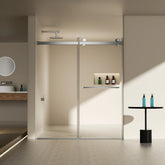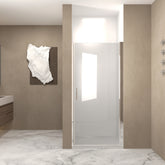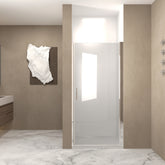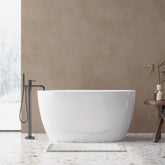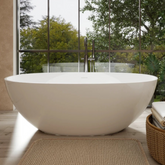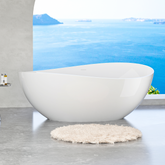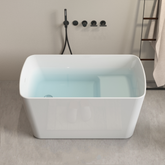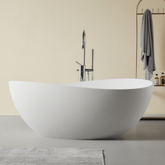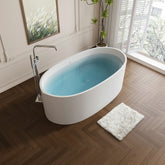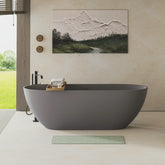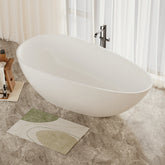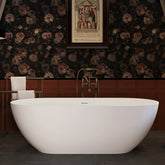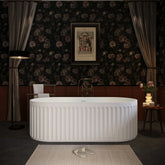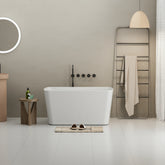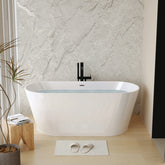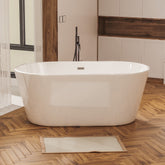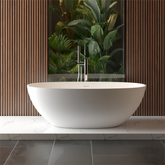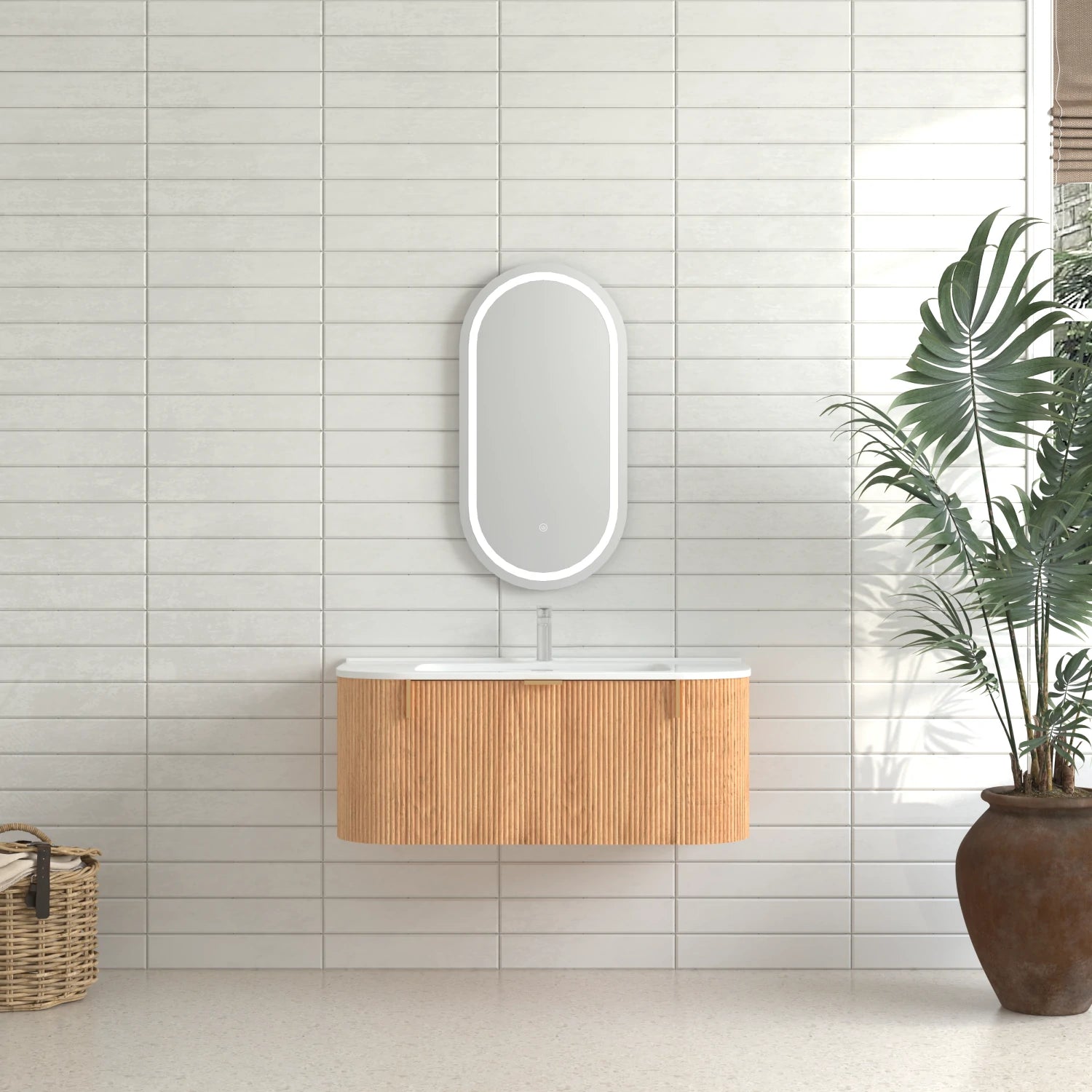Bathtub Materials Explained: Acrylic, Cast Iron, Stone & More
1. Introduction
When I first started exploring different bathtub materials, I realized how much the right choice can transform not just the look of a bathroom, but also the entire bathing experience. Whether you’re renovating a modern apartment or designing a luxury spa retreat, the material of your bathtub plays a crucial role in its comfort, durability, and aesthetic appeal.
Every material — from acrylic and cast iron to stone and beyond — offers its own personality. Acrylic bathtubs, for instance, are lightweight and affordable, perfect for contemporary homes. In contrast, cast iron bathtubs are timeless and incredibly durable, ideal for those who value longevity and heat retention. Meanwhile, stone bathtubs stand out as symbols of luxury, bringing natural beauty and a sense of permanence to any bathroom space.
In this guide, I’ll break down the most common types of bathtubs and explain their key differences — including pros, cons, and expert insights from real-world experience. By the end, you’ll have a clear understanding of which bathtub material best matches your lifestyle, design vision, and maintenance preferences.
Let’s dive in and uncover what truly lies beneath the surface of your next relaxing soak.

2. Why Material Choice Matters
When I design or select a bathtub, I always start by considering the material. It’s not just about looks — the bathtub material determines how it feels to the touch, how long it lasts, and even how enjoyable every soak will be. The choice of material affects nearly every aspect of daily use, from durability and heat retention to cleaning, installation, and overall cost.
Durability and Longevity
Each material comes with its own level of strength and resistance. Cast iron bathtubs are known for their solid structure and decades-long lifespan, while acrylic bathtubs offer a lightweight yet durable option that can handle everyday use without losing their shine. Meanwhile, stone bathtubs are almost eternal — they’re built to last generations but require a bit more care due to their natural surface.
Heat Retention and Comfort
One of the most underrated aspects of bathtub selection is heat retention. When I sink into a bath, I want the water to stay warm as long as possible. Cast iron and stone bathtubs excel here, keeping the water warm for extended periods, while acrylic and fiberglass tubs heat up quickly but may cool down faster. If you love long, relaxing baths, this factor alone can make or break your experience.
Ease of Cleaning and Maintenance
Maintenance often influences long-term satisfaction. Acrylic and fiberglass bathtubs are easier to clean due to their smooth, non-porous surfaces. Stone and cast iron bathtubs, though more luxurious, may require specialized cleaners or occasional resealing to maintain their pristine finish. Choosing the right material means finding the perfect balance between beauty and practicality.
Installation and Cost Considerations
The weight of the bathtub material affects how and where it can be installed. For instance, cast iron and stone bathtubs are heavy and often need reinforced flooring, which can increase installation costs. On the other hand, acrylic and fiberglass tubs are light, making them easier to move and install — and typically more budget-friendly.
Enhancing Comfort and Style
Ultimately, the right material enhances both user comfort and bathroom aesthetics. A glossy acrylic finish adds a clean, modern touch, while a matte stone surface creates a spa-like atmosphere. When you align your material choice with your personal comfort and design goals, the bathtub becomes more than a fixture — it becomes the centerpiece of your bathroom sanctuary.

3. Acrylic Bathtubs
Among all the bathtub materials I’ve worked with, acrylic bathtubs stand out as one of the most versatile and popular options. They’ve become a modern bathroom favorite for a reason — combining style, comfort, and practicality at a price point that makes sense for most homeowners. Whether you’re designing a sleek apartment or renovating a family bathroom, an acrylic bathtub offers that perfect balance between affordability and elegance.
Lightweight and Easy to Install
One of the biggest advantages I’ve noticed with acrylic bathtubs is how lightweight they are compared to cast iron or stone bathtubs. This makes them much easier to transport, position, and install — even in upper-level bathrooms where heavy materials could be a challenge. For contractors and DIY renovators, this often translates into lower installation costs and fewer structural concerns.
Comfort and Heat Retention
Acrylic might be lightweight, but it still does a great job retaining heat. During my experience with various bathtub projects, I’ve found that acrylic tubs maintain a pleasantly warm water temperature for longer than most people expect. This makes them ideal for anyone who enjoys long, relaxing baths without constant refilling with hot water.
Design Flexibility and Aesthetic Variety
When it comes to design freedom, acrylic bathtubs are hard to beat. The material can be molded into virtually any shape or size — from minimalist wall-mounted designs to freestanding statement pieces. It also comes in a wide range of colors and finishes, allowing homeowners and designers to easily match the tub with different bathroom styles, from contemporary to classic.
Maintenance and Durability
While acrylic tubs are durable for everyday use, they are more prone to surface scratches compared to harder materials like cast iron or stone. However, I’ve found that small scratches can often be buffed out easily, and proper care keeps the tub looking brand new for years. Regular cleaning with mild soap and a soft cloth is usually enough to maintain its shine.
Ideal for Modern Homes and Smart Budgets
For homeowners who want a stylish yet budget-conscious upgrade, acrylic bathtubs are an excellent choice. They offer the look and comfort of luxury tubs without the high cost or heavy maintenance demands. Personally, I recommend them for modern homes, rental properties, or any renovation project where flexibility, affordability, and visual appeal all matter equally.

4. Cast Iron Bathtubs
Whenever I think of timeless elegance and lasting quality, cast iron bathtubs immediately come to mind. They represent the classic side of bathroom design — solid, refined, and built to last for generations. As one of the most durable bathtub materials ever made, cast iron combines craftsmanship with functionality, creating a bathing experience that feels both luxurious and enduring.
Classic Strength and Longevity
In my experience, few materials can match the sheer strength of cast iron. These tubs are made by pouring molten iron into molds and coating the surface with enamel, resulting in an extremely tough finish that resists chips, scratches, and wear. It’s not unusual for a cast iron bathtub to last for decades — or even be passed down through generations. For homeowners who value long-term investment, this material is worth every penny.
Unmatched Heat Retention and Comfort
One of the most remarkable features of cast iron bathtubs is their ability to retain heat. Once the tub warms up, it keeps bathwater hot for an exceptionally long time, making every soak feel indulgent and relaxing. I personally find this feature to be one of the biggest advantages over lighter materials like acrylic or fiberglass. It’s the kind of comfort that transforms an ordinary bath into a spa-like ritual.
Timeless Beauty and Versatile Design
Cast iron tubs are often associated with vintage clawfoot designs, but they’re not limited to traditional aesthetics. In recent years, I’ve seen many modern interpretations — from sleek freestanding silhouettes to matte enamel finishes — that fit beautifully in both classic and contemporary settings. The enamel coating gives them a glossy, high-end appearance that adds depth and sophistication to any bathroom.
Weight and Installation Considerations
Of course, all that durability comes at a price — literally and physically. Cast iron bathtubs are incredibly heavy, often requiring reinforced flooring and professional installation. Moving one into an upper-floor bathroom can be a challenge. From my experience, it’s essential to plan ahead and consult with your contractor before choosing this material. However, once installed, a cast iron tub is virtually indestructible and easy to maintain.
Best for Luxury and Traditional Spaces
If you’re aiming for a luxury bathroom or a traditional design, cast iron is hard to beat. It offers unmatched durability, superior heat retention, and a timeless look that never goes out of style. Though more expensive and complex to install, the investment pays off with a bathtub that exudes quality and elegance for decades. Personally, I see it as the gold standard for homeowners who want their bathroom to make a lasting impression.

5. Stone (or Solid Surface) Bathtubs
Whenever I walk into a bathroom featuring a stone bathtub, I immediately feel the sense of luxury and permanence it brings. Among all bathtub materials, natural and solid surface stone options stand out as true works of art — sculpted, elegant, and timeless. Whether made from marble, granite, or engineered resin stone, these tubs embody sophistication and craftsmanship that instantly elevate any bathroom space.
Natural Elegance and Premium Aesthetic
What I love most about stone bathtubs is their natural beauty. Each piece of marble or granite has its own unique grain and texture, giving every bathtub a one-of-a-kind look. Even engineered solid surface stone, which mimics natural stone, offers a sleek, uniform finish that fits perfectly in modern interiors. To me, a stone bathtub isn’t just a fixture — it’s a centerpiece, an expression of taste and artistry that defines the entire room.
Exceptional Durability and Longevity
In terms of durability, stone and solid surface bathtubs are virtually unmatched. They’re built to last for decades, resisting chips, scratches, and fading far better than lighter materials like acrylic or fiberglass. I’ve seen stone bathtubs maintain their pristine appearance even after years of daily use. With proper care, they become a lifetime investment, blending strength with natural resilience.
Thermal Comfort and Bathing Experience
Another remarkable quality of stone is its ability to retain heat. Once the material warms up, it holds temperature for a long time, offering a deep, soothing soak that feels indulgent and spa-like. In my experience, nothing compares to the calm, grounded feeling of bathing in a natural stone tub — it’s an experience that engages all senses, not just a routine.
Weight, Cost, and Installation Considerations
Of course, beauty and strength come with certain trade-offs. Stone bathtubs are extremely heavy, often requiring reinforced flooring and professional installation. They also tend to be among the most expensive bathtub materials due to the craftsmanship involved in shaping and finishing them. I always advise homeowners to consider structural capacity and budget before making the final decision — because while the initial cost is higher, the long-term value is undeniable.
Perfect for Luxury and Statement Bathrooms
If your goal is to create a luxury bathroom that makes a bold statement, stone or solid surface bathtubs are the ultimate choice. They bring natural warmth, sculptural presence, and a premium feel that instantly transforms any space into a private sanctuary. Personally, I see them as more than bathtubs — they’re design statements that reflect sophistication, stability, and a deep appreciation for quality craftsmanship.

6. Other Common Materials
While acrylic, cast iron, and stone bathtubs often take the spotlight, there are several other bathtub materials worth mentioning. Over the years, I’ve come across many projects where these alternative materials offered the perfect balance between style, cost, and practicality. Each comes with its own personality — from budget-friendly options like fiberglass to distinctive, artistic choices such as copper and wood.
Fiberglass Bathtubs: Lightweight and Affordable
When cost and convenience are top priorities, fiberglass bathtubs are often my go-to recommendation. They’re among the most affordable and lightweight options available, making them easy to install and replace when needed. However, their affordability does come with trade-offs — fiberglass isn’t as durable as materials like acrylic or cast iron. Over time, it can develop small cracks or lose its glossy finish. Still, for rental properties or short-term renovations, it’s a practical choice that balances function and budget.
Steel Enamel Bathtubs: Strength with a Sleek Finish
I’ve always admired the sleek, polished surface of steel enamel bathtubs. Made by coating a steel base with a layer of enamel, these tubs are resistant to scratches and chemicals, offering a clean and durable finish. They’re also thinner and lighter than cast iron bathtubs, which makes installation easier. However, one thing to note is that steel doesn’t retain heat well — it can feel cold to the touch until the water warms it up. Despite this, their modern appearance and solid build make them a reliable choice for contemporary bathrooms.
Copper Bathtubs: Unique and Naturally Beautiful
Copper bathtubs are truly one of a kind. Every time I see one, it feels like stepping into a piece of functional art. Beyond their stunning color and natural patina, copper tubs have antimicrobial properties and excellent heat retention. They warm up quickly and keep the bathwater at a comfortable temperature. However, they require a higher budget and proper care to maintain their distinctive shine — which, in my opinion, is well worth the effort for anyone seeking a luxurious, rustic look.
Wood Bathtubs: Organic Warmth and Artisan Craftsmanship
There’s something undeniably calming about bathing in a wood bathtub. It brings a sense of nature and tranquility into the bathroom, turning an ordinary soak into a meditative experience. Typically crafted from teak or hinoki, these tubs are treated to resist water and moisture. While they demand regular maintenance and come with a higher price tag, their organic warmth and artisanal feel make them perfect for spa-inspired or custom-designed bathrooms.
Finding Balance Between Style and Function
These alternative bathtub materials — fiberglass, steel enamel, copper, and wood — each have their own strengths and character. Choosing the right one depends on your design vision, lifestyle, and budget. Whether you prefer the practicality of fiberglass, the resilience of steel, or the natural beauty of copper and wood, each material can bring a unique charm and functionality to your bathroom space.

7. Comparison Table: Material vs Key Features
After testing and working with different bathtub materials over the years, I’ve found that seeing their strengths and weaknesses side by side makes the decision process much clearer. Each material — from acrylic to cast iron and stone — performs differently in areas like durability, heat retention, and maintenance. Below is a practical comparison chart I often refer to when helping clients choose the right bathtub for their needs and lifestyle.
| Material | Durability | Heat Retention | Maintenance | Weight | Cost Level | Best For |
|---|---|---|---|---|---|---|
| Acrylic | Good | Moderate to Good | Easy | Light | $$ | Modern homes, budget-conscious buyers |
| Cast Iron | Excellent | Excellent | Low | Heavy | $$$$ | Luxury bathrooms, traditional designs |
| Stone / Solid Surface | Exceptional | Excellent | Moderate | Very Heavy | $$$$$ | Luxury and statement bathrooms |
| Fiberglass | Fair | Average | Easy | Light | $ | Budget or rental homes |
| Steel Enamel | Good | Low to Moderate | Easy | Moderate | $$$ | Modern minimalist bathrooms |
| Copper | Excellent | Excellent | Moderate | Heavy | $$$$ | Luxury or rustic-style bathrooms |
| Wood | Good (with care) | Good | High | Moderate to Heavy | $$$$ | Spa-inspired or custom bathrooms |
Interpreting the Comparison
From my perspective, this table isn’t just a checklist — it’s a guide to lifestyle fit. If you prioritize comfort and easy maintenance, acrylic or fiberglass might be your best match. If you value long-term durability and design prestige, cast iron or stone bathtubs offer unmatched appeal. And for those looking to make a design statement, materials like copper or wood bring individuality and warmth that no synthetic surface can replicate.
Ultimately, there’s no single “best” bathtub material — only the one that best complements your lifestyle, design vision, and sense of comfort. The key is to balance practicality with personality, and that’s where true bathroom design harmony begins.
8. How to Choose the Right Bathtub Material
Balancing Beauty and Practicality
When I help clients choose a bathtub, I always start by balancing two things — aesthetics and practicality. The perfect bathtub isn’t just about how it looks; it’s about how it feels, how easy it is to maintain, and how well it fits your space. Whether you’re drawn to the glossy finish of acrylic, the timeless charm of cast iron, or the natural luxury of stone bathtubs, your material choice defines both the comfort and longevity of your bathroom.
Key Factors to Consider
- Bathroom Size: A compact bathroom benefits from a lightweight material like acrylic or fiberglass, while spacious layouts can handle the mass and elegance of stone or cast iron tubs.
- Floor Strength: Always check floor support before choosing heavy materials like stone or solid surface bathtubs — they can weigh several hundred pounds when filled with water.
- Budget: Acrylic and fiberglass offer affordable options with modern appeal, while stone and copper are investments in long-term luxury.
- Maintenance Preference: If you prefer low-maintenance living, acrylic or enamel-coated steel bathtubs are easier to clean compared to porous natural stone surfaces.
- Design Goals: Think about your overall bathroom theme — sleek modern, rustic natural, or classic vintage. The bathtub material should complement the vanity, faucet, and lighting for a cohesive design.
My Advice
In my experience, the “best” bathtub material depends on lifestyle. If you love long, hot soaks, go for a material with excellent heat retention like cast iron or stone. If flexibility and cost-efficiency matter more, acrylic is your best friend. Ultimately, your bathtub should reflect both your taste and how you live — a harmony between design and daily comfort.

9. Sustainability and Maintenance Tips
Choosing Eco-Friendly Bathtub Materials
Over the years, I’ve become more conscious of the environmental impact of bathroom renovations. When selecting bathtub materials, I always look for eco-friendly options. Recyclable acrylic and sustainably sourced stone bathtubs are excellent choices for homeowners who want to reduce their footprint without sacrificing style. Even materials like copper and wood can be environmentally responsible when sourced from certified sustainable suppliers.
Maintaining Your Bathtub for Longevity
Proper maintenance is key to extending the life of your bathtub, regardless of the material. From my experience:
- Acrylic and Fiberglass: Clean regularly with mild, non-abrasive cleaners to prevent scratches and keep the surface glossy.
- Cast Iron: Wipe down after each use to maintain the enamel finish and prevent rust spots.
- Stone / Solid Surface: Seal natural stone surfaces periodically and avoid harsh chemicals that can damage the finish.
- Copper and Wood: Use gentle cleaners and follow manufacturer-recommended treatments to preserve their natural patina and prevent water damage.
Small Habits, Big Impact
I’ve found that a few simple habits can dramatically improve a bathtub’s lifespan: rinse after use, avoid dropping heavy objects, and address stains immediately. By pairing sustainable material choices with thoughtful maintenance, your bathtub not only lasts longer but also aligns with a more eco-conscious lifestyle — making every soak feel indulgent and responsible.

10. Conclusion
Key Takeaways on Bathtub Materials
After working with a variety of bathtub materials over the years, I’ve learned that each option brings its own unique combination of style, durability, and comfort. Acrylic bathtubs offer affordability and flexibility, cast iron provides timeless durability and heat retention, and stone or solid surface tubs deliver luxury and sculptural beauty. Other materials like fiberglass, steel enamel, copper, and wood also have their own niches, catering to specific budgets, design visions, and lifestyles.
Balancing Style, Comfort, and Practicality
Choosing the right bathtub is about more than picking the most beautiful finish — it’s about aligning your material choice with your lifestyle, bathroom size, maintenance preferences, and long-term investment goals. In my experience, the best results come from balancing aesthetics with practicality, ensuring that every soak is as enjoyable as it is visually satisfying.
Your Next Step
Whether you’re renovating, upgrading, or designing a new bathroom, the right bathtub material can transform the entire space. I encourage you to carefully weigh your options and choose a material that supports both your comfort and design vision. Explore our collection of high-quality bathtubs crafted from durable materials that suit every lifestyle and design.
Featured Products
AISU 47" Acrylic Freestanding Bathtub-Acrylic Soaking Tubs, White Color, Oval Shape, Pop-Up Drain CUPC Certificate
- $739.16
- $739.16
- Unit price
- / per
AISU 65" Freestanding Solid Surface Bathtub, Handcrafted Stone Resin with Overflow and Pop-up Drain, Glossy White
- $1,585.43
- $1,585.43
- Unit price
- / per
AISU 63" Freestanding Solid Surface Bathtub, Engineered Stone Resin with Overflow and Pop-up Drain for Contemporary Bathroom, Glossy White
- $1,700.09
- $1,700.09
- Unit price
- / per
AISU 49” Acrylic Freestanding Soaking Bathtub, Square-shape Japanese Soaking Hot Tub, Glossy White
- $766.77
- $766.77
- Unit price
- / per
AISU 63" Luxury Freestanding Solid Surface Bathtub, Matte White
- $1,700.09
- $1,700.09
- Unit price
- / per
AISU 65" Freestanding Solid Surface Bathtub, Stone Resin Freestanding Bath Tub with Overflow and Pop-up Drain, Matte White
- $1,716.81
- $1,716.81
- Unit price
- / per
AISU Luxury Engineered Solid Surface Bathtub, Stone Resin Freestanding Soaking Bathtub with Overflow and Pop-up Drain for Contemporary Bathroom, Matte Grey
- from $1,645.26
- from $1,645.26
- Unit price
- / per
AISU 59" Freestanding Solid Surface Bathtub, Luxury Handcrafted Stone Resin Freestanding Soaking Bathtub with Overflow and Pop-up Drain, Glossy White
- $1,506.75
- $1,506.75
- Unit price
- / per
AISU 67" Freestanding Solid Surface Bathtub, Stone Resin Freestanding Bath Tub with Overflow and Pop-up Drain, Matte White
- $1,801.71
- $1,801.71
- Unit price
- / per
AISU Freestanding Solid Surface Bathtub, Luxury Engineered Stone Resin Freestanding Soaking Bathtub with Overflow and Pop-up Drain for Contemporary Bathroom, Matte White
- from $1,533.26
- from $1,533.26
- Unit price
- / per
AISU 67" Freestanding Solid Surface Bathtub, Luxury Engineered Stone Resin Freestanding Soaking Bathtub with Overflow and Pop-up Drain cUPC Certified, Matte White
- $1,944.21
- $1,944.21
- Unit price
- / per
AISU 49'' Acrylic Freestanding Soaking Bathtub, Square-shape Japanese Soaking Hot Tub, Chrome Overflow and Quick Drain
- from $775.48
- from $775.48
- Unit price
- / per
-
Glossy White
-
Glossy Black
AISU Acrylic Freestanding Bathtub, Stand Alone Soaking Tub, Glossy White Acrylic, Toe-tap Chrome Drain, cUPC Certified
- from $743.66
- from $743.66
- Unit price
- / per
60'' Freestanding Gloss White Acrylic Soaking Bathtub with Toe-Tap Chrome Drain and Classic Slotted Overflow
- $1,029.19
- $1,029.19
- Unit price
- / per
65" Freestanding Solid Surface Bathtub with Overflow and Pop-up Drain, Matte White
- $1,584.73
- $1,584.73
- Unit price
- / per
